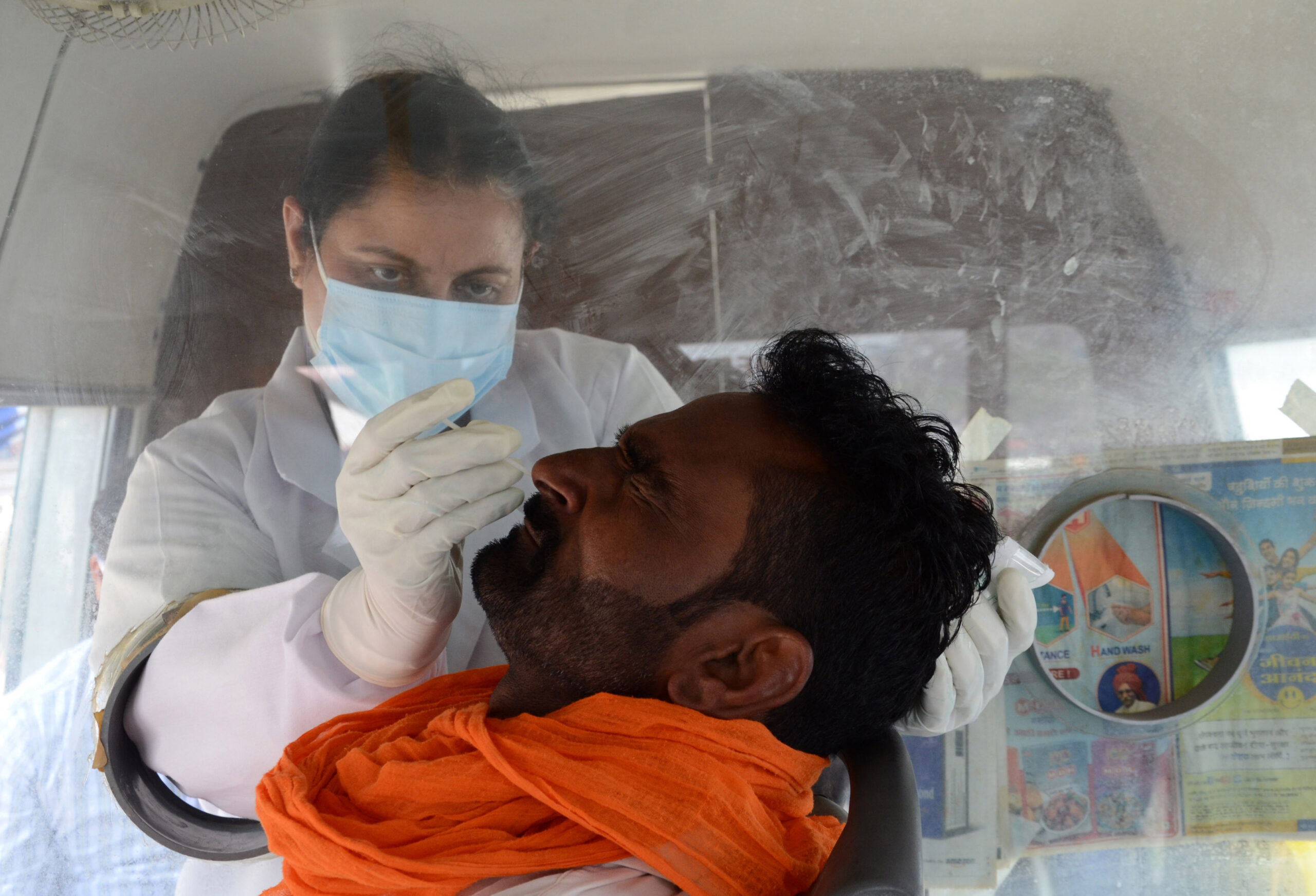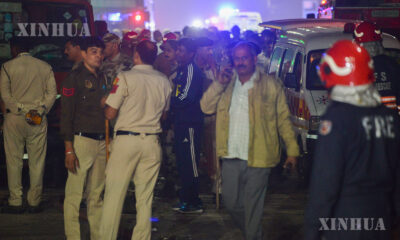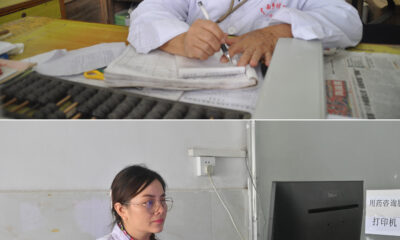Asia
အိန္ဒိယနိုင်ငံတွင် COVID-19 ဒုတိယလှိုင်းအတွင်း ဆရာဝန် ၆၀၀ နီးပါး သေဆုံးခဲ့ကြောင်း ဆေးဘက်ဆိုင်ရာ အသင်းက ပြောကြား

နယူးဒေလီ ၊ ဇွန် ၃ ရက်(ဆင်ဟွာ)
အိန္ဒိယနိုင်ငံ၌ ဧပြီလမှ မေလအထိ COVID-19 ကပ်ရောဂါ ဒုတိယလှိုင်းကာလအတွင်း ဆရာဝန် ၅၉၄ ဦး သေဆုံးခဲ့ကြောင်း အိန္ဒိယဆေးဘက်ဆိုင်ရာအသင်း(IMA)က ဇွန် ၂ ရက်တွင် ပြောကြားခဲ့သည်။အိန္ဒိယနိုင်ငံ မြို့တော် ဒေလီ၌ သေဆုံးသူ ၁၀၇ ဦးနှင့်အတူ စာရင်းထိပ်ဆုံး၌ တည်ရှိနေပြီး ယင်းနောက်တွင် ဘီဟာပြည်နယ်၌ သေဆုံးသူ ၉၆ ဦး ၊ Uttar Pradesh ပြည်နယ်၌ သေဆုံးသူ ၆၇ ဦးရှိကြောင်း သိရသည်။
သို့သော်လည်း အိန္ဒိယဆေးဘက်ဆိုင်ရာအသင်း(IMA)သည် အိန္ဒိယနိုင်ငံရှိ ဆရာဝန်များ၏ စေတနာ့ဝန်ထမ်းအဖွဲ့အစည်းသာဖြစ်ရာ အမှန်တကယ် သေဆုံးသူအရေအတွက်သည် ယင်းကိန်းဂဏန်းအချက်အလက်များထက် ကျော်လွန်နိုင်ကြောင်း ၊ နိုင်ငံအတွင်းရှိ ဆရာဝန် ၁ ဒသမ ၂ သန်း နီးပါးအနက် အသင်းဝင် ၃၅၀,၀၀၀ ဦးကိုသာ စာရင်းပြုစုနိုင်သည့်အတွက် ဖြစ်ကြောင်း အင်္ဂလိပ်ဘာသာ နေ့စဉ်သတင်းစာဖြစ်သည့် The Hindustan Times က ဖော်ပြခဲ့သည်။
အိန္ဒိယနိုင်ငံတွင် နေ့စဉ်ကိုဗစ်ကူးစက်ခံရမှုအမြင့်ဆုံး လူပေါင်း ၄ သိန်းကျော်ရှိခဲ့ခြင်းနှင့်အတူ လူအသေအပျောက်များခဲ့သည့် ဒုတိယလှိုင်းရိုက်ခတ်မှုဒဏ်ကို ဆိုးဆိုးရွားရွားခံစားခဲ့ရသလို နေ့စဉ် တစ်ရက်လူနာသေနှုန်း ၄ ထောင်ကျော် အရေအတွက်မှာလည်း ရက်ပေါင်းများစွာရှိနေခဲ့ကြောင်း သိရသည်။
သို့သော် လွန်ခဲ့သော ရက်အနည်းငယ်အတွင်း နိုင်ငံအနှံ့ COVID-19 လူနာသစ် နှင့် သေဆုံးသူ အရေအတွက် နှစ်ခုလုံးသည် ကျဆင်းသွားသည်ကို တွေ့မြင်ခဲ့ရသည်။
ဗိုင်းရပ်စ်အား စဉ်ဆက်မပြတ်ထိတွေ့ခြင်းက ဆေးဘက်ဆိုင်ရာအသိုင်းအဝိုင်းများအကြားတွင် လူသေဆုံးမှုများစွာ ဖြစ်ပေါ်စေနိုင်ကြောင်း Uttar Pradesh ပြည်နယ်အနောက်ဘက် Saraswathi ဆေးဘက်ဆိုင်ရာ သိပ္ပံဌာန(SIMS) COVID-19 စောင့်ရှောက်ရေးစင်တာရှိ အဏုဇီဝပညာရှင် ဒေါက်တာ Krati Varshney က ဒုတိယလှိုင်းအတွင်း ဆေးဘက်ဆိုင်ရာဆရာဝန်များ၏ သေဆုံးမှုများ အရေအတွက် များပြားရခြင်းအပေါ် မှတ်ချက်ပေးရာတွင် ပြောကြားခဲ့သည်။
“စဉ်ဆက်မပြတ်ထိတွေ့မှုကြောင့် သူတို့ သေဆုံးခဲ့ပါတယ်။ တစ်ခါတစ်ရံ COVID-19 စောင့်ရှောက်ရေးစင်တာတွေမှာ အလုပ်လုပ်ချိန် ရှည်ကြာလွန်းတော့ ဆရာဝန်တွေအားလုံးဟာ ထိန်းသိမ်းဖို့ အလွန်ခက်ခဲမှုတွေ ဖြစ်လာပါတယ်။”SIMS ၌ RT-PCR ဓာတ်ခွဲနမူနာများအား စစ်ဆေးသူ အဏုဇီဝပညာရှင်က ပြောကြားခဲ့သည်။
အခြားအကြောင်းပြချက်တစ်ခုကို ကိုးကား၍ ၎င်းက ထည့်သွင်းပြောကြားရာတွင် သေဆုံးမှုအများဆုံးဖြစ်ရပ်ထဲတွင် ဆရာဝန်များနှင့် ဆေးဘက်ဆိုင်ရာဝန်ထမ်းများသည် အဝတ်လျော်ခြင်း နှင့် အဝတ်လဲခြင်းတို့ကို နေရာတစ်ခုတည်းတွင်အတူတကွ ပြုလုပ်ကြရာမှ ယင်းနေရာများသည်တစ်ဦးနှင့်တစ်ဦး ဗိုင်းရပ်စ်ကူးစက်မှု အတွက် မြစ်ဖျားခံရာ ဖြစ်လာခဲ့ကြောင်း ဆိုသည်။
“အချို့ဖြစ်ရပ်တွေကတော့ အချိန်ကြာရှည်စွာ တာဝန်ထမ်းဆောင်ရတာရယ် တာဝန်ချိန်များတော့ ပင်ပန်းနွမ်းနယ်တာရယ်ကြောင့် ဆရာဝန်တွေ စိတ်ဓာတ်ကျလာပြီး လူရဲ့ကိုယ်ခံအားကျသွားလို့လည်းပါပါတယ် ” ဟု ဒေါက်တာ Krati က ဆိုသည်။ (Xinhua)
——————————————
(English Version)
Nearly 600 doctors dead in India’s COVID-19 2nd wave: Indian Medical Association
NEW DELHI, June 2 (Xinhua) — As many as 594 doctors died during the second wave of COVID-19 pandemic in India from April to May, said the Indian Medical Association (IMA) Wednesday.
The national capital Delhi topped the list with 107 deaths, followed by Bihar with 96 such fatalities and Uttar Pradesh with 67 deaths.
However, the IMA being a voluntary organisation of physicians in India, it is possible that the actual number of fatalities far exceeds these statistics, since the association only keeps a record of its 350,000 members, out of the nearly 1.2 million doctors in the country, reported the English daily “The Hindustan Times”.
India was hit hard by the deadly second wave, with daily spike of cases crossing the 400,000-mark for times, and daily deaths surpassing 4,000 on several days.
However, over the past few days, a decline in both the new COVID-19 cases and the deaths has been seen across the country.
Commenting on the large number of medical practitioners’ deaths during the second wave, Dr Krati Varshney, a microbiologist at the COVID-19 care centre “Saraswathi Institute of Medical Sciences (SIMS)”, based in western Uttar Pradesh, said that “constant exposure” to the virus might have led to so many casualties among the medical community.
“They died due to constant exposure. At times it becomes very difficult to maintain all precautions during the long duty hours at COVID care centres. Even with PPE kits on, sometimes one gets inadvertently exposed the deadly virus,” said the microbiologist who tests RT-PCR samples at SIMS.
Citing another reason, she added that in most cases doctors and medical staff had common washing and changing areas, which might also have led to the transmission of virus from each another.”In some cases, depression that crept in among the doctors during long and exhausting duty hours might have led to a reduction in overall immunity levels,” added Dr. Krati. Enditem






